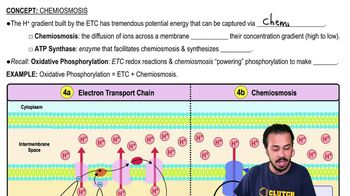All cells are able to synthesize ATP via the process of glycolysis. In many cells, if oxygen is not present, pyruvate (pyruvic acid) is metabolized in a process called “fermentation.” By oxidizing the NADH produced in glycolysis, fermentation regenerates NAD+, which can take part in glycolysis once again to produce more ATP. The net energy gain in fermentation is two ATP molecules per molecule of glucose. Fermentation complements glycolysis and makes it possible for ATP to be continually produced in the absence of oxygen. Two common types of fermentation are described here. Alcohol fermentation, which occurs in yeast, results in the production of ethanol and carbon dioxide. Lactic acid fermentation, which occurs in muscle, results in the production of lactate (lactic acid). Let’s see the relationship between glycolysis and alcohol fermentation. Glycolysis produces NADH, ATP, and pyruvate (pyruvic acid). If oxygen is not present, NADH cannot be oxidized in the electron transport chain. Without fermentation, the cell would run out of NAD+, bringing glycolysis to a halt. In alcohol fermentation, the pyruvate (pyruvic acid) from glycolysis loses one carbon in the form of carbon dioxide and the product is then reduced to ethanol by NADH. With the formation of ethanol, NADH is oxidized and becomes NAD+. With a continuous supply of NAD+, glycolysis can continue, producing more ATP. During fermentation, the NADH produced by glycolysis is oxidized, ensuring a continuous supply of NAD+ for glycolysis. Alcohol fermentation occurs in yeast cells. Let’s observe the relationship between glycolysis and lactic acid fermentation. Glycolysis produces NADH, ATP, and pyruvate (pyruvic acid). If oxygen is not present, NADH cannot be oxidized in the electron transport chain. Without fermentation, the cell would run out of NAD+, bringing glycolysis to a halt. In lactic acid fermentation, the pyruvate (pyruvic acid) from glycolysis is reduced to lactate (lactic acid) by NADH. With the formation of lactate (lactic acid), NADH is oxidized and becomes NAD+. With a continuous supply of NAD+, glycolysis can continue producing more ATP. During fermentation, the NADH produced by glycolysis is oxidized, ensuring a continuous supply of NAD+ for glycolysis. Lactic acid fermentation occurs in muscle cells.
Table of contents
- 1. Introduction to Biology2h 40m
- 2. Chemistry3h 40m
- 3. Water1h 26m
- 4. Biomolecules2h 23m
- 5. Cell Components2h 26m
- 6. The Membrane2h 31m
- 7. Energy and Metabolism2h 0m
- 8. Respiration2h 40m
- 9. Photosynthesis2h 49m
- 10. Cell Signaling59m
- 11. Cell Division2h 47m
- 12. Meiosis2h 0m
- 13. Mendelian Genetics4h 41m
- Introduction to Mendel's Experiments7m
- Genotype vs. Phenotype17m
- Punnett Squares13m
- Mendel's Experiments26m
- Mendel's Laws18m
- Monohybrid Crosses16m
- Test Crosses14m
- Dihybrid Crosses20m
- Punnett Square Probability26m
- Incomplete Dominance vs. Codominance20m
- Epistasis7m
- Non-Mendelian Genetics12m
- Pedigrees6m
- Autosomal Inheritance21m
- Sex-Linked Inheritance43m
- X-Inactivation9m
- 14. DNA Synthesis2h 27m
- 15. Gene Expression3h 20m
- 16. Regulation of Expression3h 31m
- Introduction to Regulation of Gene Expression13m
- Prokaryotic Gene Regulation via Operons27m
- The Lac Operon21m
- Glucose's Impact on Lac Operon25m
- The Trp Operon20m
- Review of the Lac Operon & Trp Operon11m
- Introduction to Eukaryotic Gene Regulation9m
- Eukaryotic Chromatin Modifications16m
- Eukaryotic Transcriptional Control22m
- Eukaryotic Post-Transcriptional Regulation28m
- Eukaryotic Post-Translational Regulation13m
- 17. Viruses37m
- 18. Biotechnology2h 58m
- 19. Genomics17m
- 20. Development1h 5m
- 21. Evolution3h 1m
- 22. Evolution of Populations3h 52m
- 23. Speciation1h 37m
- 24. History of Life on Earth2h 6m
- 25. Phylogeny40m
- 26. Prokaryotes4h 59m
- 27. Protists1h 6m
- 28. Plants1h 22m
- 29. Fungi36m
- 30. Overview of Animals34m
- 31. Invertebrates1h 2m
- 32. Vertebrates50m
- 33. Plant Anatomy1h 3m
- 34. Vascular Plant Transport2m
- 35. Soil37m
- 36. Plant Reproduction47m
- 37. Plant Sensation and Response1h 9m
- 38. Animal Form and Function1h 19m
- 39. Digestive System10m
- 40. Circulatory System1h 57m
- 41. Immune System1h 12m
- 42. Osmoregulation and Excretion50m
- 43. Endocrine System4m
- 44. Animal Reproduction2m
- 45. Nervous System55m
- 46. Sensory Systems46m
- 47. Muscle Systems23m
- 48. Ecology3h 11m
- Introduction to Ecology20m
- Biogeography14m
- Earth's Climate Patterns50m
- Introduction to Terrestrial Biomes10m
- Terrestrial Biomes: Near Equator13m
- Terrestrial Biomes: Temperate Regions10m
- Terrestrial Biomes: Northern Regions15m
- Introduction to Aquatic Biomes27m
- Freshwater Aquatic Biomes14m
- Marine Aquatic Biomes13m
- 49. Animal Behavior28m
- 50. Population Ecology3h 41m
- Introduction to Population Ecology28m
- Population Sampling Methods23m
- Life History12m
- Population Demography17m
- Factors Limiting Population Growth14m
- Introduction to Population Growth Models22m
- Linear Population Growth6m
- Exponential Population Growth29m
- Logistic Population Growth32m
- r/K Selection10m
- The Human Population22m
- 51. Community Ecology2h 46m
- Introduction to Community Ecology2m
- Introduction to Community Interactions9m
- Community Interactions: Competition (-/-)38m
- Community Interactions: Exploitation (+/-)23m
- Community Interactions: Mutualism (+/+) & Commensalism (+/0)9m
- Community Structure35m
- Community Dynamics26m
- Geographic Impact on Communities21m
- 52. Ecosystems2h 36m
- 53. Conservation Biology24m
8. Respiration
Chemiosmosis
Video duration:
3mPlay a video:
Related Videos
Related Practice











